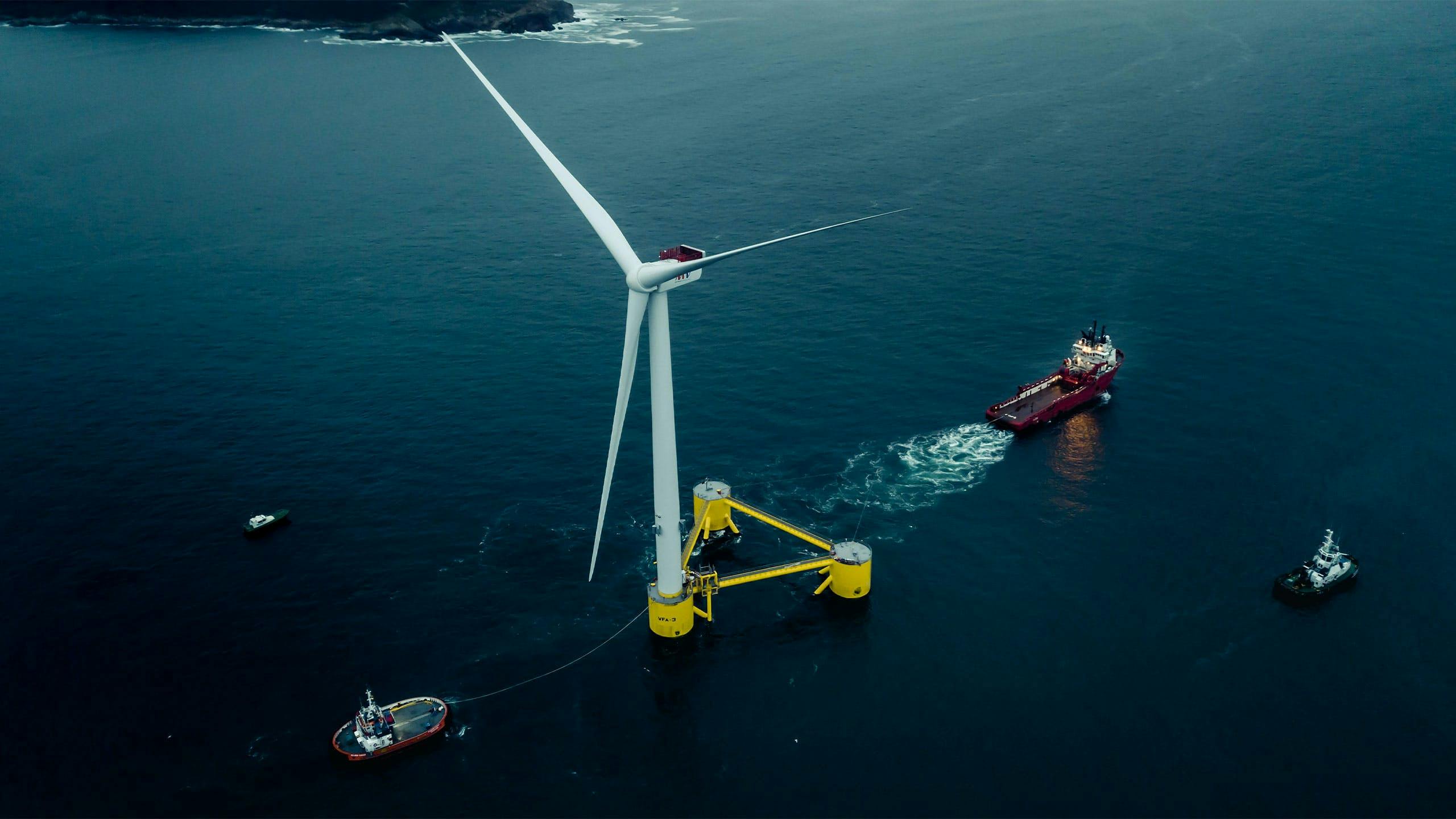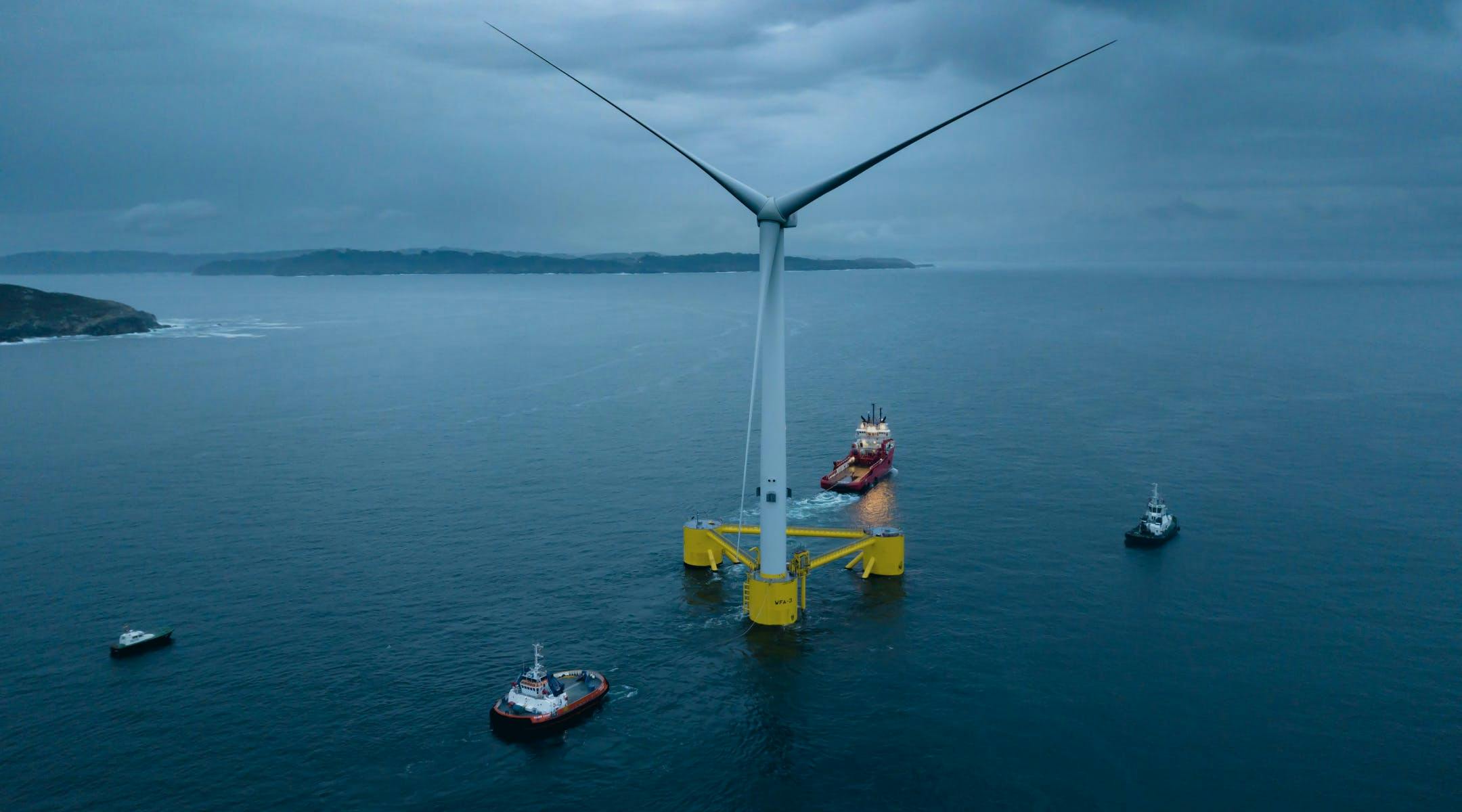
The first WindFloat Atlantic unit – featuring the world’s largest offshore wind turbine on a floating platform – has departed for its final destination off the Portuguese coast of Viana do Castelo, where the commissioning of the floating wind farm will take place.
The project will speed up the commercial deployment of innovative WindFloat® technology that harnesses the wealth of wind resources in transitional and deep waters, which were previously inaccessible. WindFloat Atlantic project marks an important milestone for the industry as this is the first semi-submersible floating wind farm in the world.
Because it can be placed in very deep waters, WindFloat® can unlock energy resources in vast areas of the sea, addressing major societal challenges, such as the clean energy transition, energy security, and climate change, whilst bringing jobs, economic growth, and opportunities for sustainable investment.
Windplus is a consortium made up of EDP Renewables, ENGIE, Repsol, and Principle Power.

The first WindFloat Atlantic platform with the turbine fully installed has set off from the Spanish Port of Ferrol towards its final destination 20 km off the coast of Viana do Castelo in Portugal. Once at the final location, the three floating structures –stretching 30 meters in height and with a distance between each one of their columns of 50 meters – will be installed to form the first floating wind farm in continental Europe.
The structure that has set off from the outer harbor of Ferrol comprises a floating platform and a wind turbine, the largest installed on a surface of these characteristics to date. In the coming months, two other platforms will be added to complete the windfarm which, with its 25MW installed capacity, will be able to generate enough energy to supply the equivalent of 60,000 users each year.
About WindFloat Atlantic
The project is led by the Windplus consortium, comprising EDP Renewables (54.4%), Engie (25%), Repsol (19.4%), and Principle Power Inc. (1.2%). The facility has three wind turbines mounted on floating platforms which are anchored only with chains to the seabed at a depth of 100 m. It includes cutting-edge technology that minimizes the environmental impact and facilitates access to untapped wind resources in deep waters. This technology has wide-reaching benefits that enhance its accessibility and cost-effectiveness, including its aptness for dry-dock assembly and towing without the need for specialized towing craft, or the advantages of not having to rely on complex offshore operations associated with the installation of traditional bottom-fixed structures.
WindFloat Atlantic project builds on the success of the WindFloat1 prototype, which was in operations between 2011 and 2016. The 2MW prototype successfully generated energy uninterruptedly over five years, surviving extreme weather conditions, including waves up to 17 meters tall and 60-knot winds, completely unscathed.
The transport alone of the first of the three floating structures making up the floating wind farm at Viana do Castelo marks a milestone in itself, as it sidesteps the need for towing craft designed specifically for this process. This benefit, alongside the simple mooring process, make it possible to replicate this initiative in other geographical areas and facilitates the commissioning phase regardless of geographical boundaries.
The WindFloat can also support the world’s largest commercially available wind turbines on a floating structure of almost 9 MW each, helping to increase power generation and drive significant reductions in lifecycle costs.
The platforms have been built in cooperation between the two countries on the Iberian peninsula: two of the platforms were manufactured at the Setúbal shipyards (Portugal), and the third at Avilés and Ferrol shipyards (Spain). The project uses WindFloat disruptive technology, which enables wind platforms to be installed in deep waters, inaccessible to date, where abundant wind resources can be harnessed.
This initiative has had the support of public and private institutions, encouraging companies that are leaders in their respective markets to take part in the project; while the Government of Portugal, the European Commission, and the European Investment Bank have provided financial support.
The partners that have made this project possible include Principle Power, the joint venture between Navantia/Windar, the A- Silva Matos Group, Bourbon, the wind turbine supplier MHI Vestas and dynamic cable supplier JDR Cables.
About EDP Renováveis (EDPR)
EDP Renováveis (Euronext: EDPR) is a global leader in the renewable energy sector and the fourth-largest producer of wind energy in the world. With a robust portfolio of projects in development, assets of the highest quality and one of the top exploitation capacities in the market, EDPR has experienced remarkable development in recent years and is already present in 14 international markets (Belgium, Brazil, Canada, Colombia, France, Greece, Italy, Mexico, Poland, Portugal, Romania, Spain, the United Kingdom, and the United States). Energias de Portugal, S.A. (EDP), the principal shareholder of EDPR, is a leading international electricity company in value creation, innovation, and sustainability. EDP has been part of the Dow Jones Sustainability Index for 11 consecutive years.
About ENGIE
Our group is a global reference in low-carbon energy and services. In response to the urgency of climate change, our ambition is to become the world leader in the zero-carbon transition “as a service” for our customers, in particular global companies and local authorities. We rely on our key activities (renewable energy, gas, services) to offer competitive turnkey solutions.
With our 160,000 employees and our customers, partners and stakeholders, we are a community of Imaginative Builders, committed every day to more harmonious progress.
Turnover in 2018: 60.6 billion euros. The Group is listed on the Paris and Brussels stock exchanges (ENGI) and is represented in the main financial indices (CAC 40, DJ Euro Stoxx 50, Euronext 100, FTSE Eurotop 100, MSCI Europe) and non-financial indices (DJSI World, DJSI Europe, and Euronext Vigeo Eiris - World 120, Eurozone 120, Europe 120, France 20, CAC 40 Governance).
About Repsol
Repsol is a global company that is present throughout the entire energy value chain. The company employs more than 25,000 people and its products are sold in more than 90 countries, reaching 10 million customers. It produces around 700,000 barrels of oil equivalent per day and has one of the most efficient refining systems in Europe, capable of processing more than one million barrels of crude oil daily. The company is well-positioned for the energy transition with its focus on developing gas production projects. It operates low-emissions electricity generation assets, including photovoltaic power projects, and is pioneering development of mobility initiatives to create new solutions and energy sources for transportation. The company distributes and sells fuels and lubricants through its more than 4,700 service stations in Spain, Portugal, Peru, Italy, and Mexico, making it a leader in this sector. It is also the leading player in Spain’s liquefied petroleum gas (LPG) market.
About Principle Power
Principle Power is a global energy company that enables origination and development and offers technology and service solutions to harvest the full potential of the world’s energy resources, by providing access to transitional and deep-water offshore wind sites that were previously inaccessible.
With its proven and in-demand WindFloat technology, Principle Power is the commercial market leader in floating offshore wind. By simplifying the way offshore wind is deployed, this unique technology assists the ongoing development of the offshore wind industry as a whole, opens new deep-water markets, and has the potential to substantially decrease the cost and risk profile of offshore wind projects globally.




